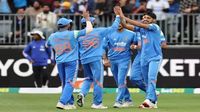The much-anticipated ODI series between Australia and India kicked off in dramatic fashion at the Optus Stadium in Perth on October 19, 2025. Cricket fans worldwide had circled this date on their calendars, eager to witness the return of Indian legends Rohit Sharma and Virat Kohli to the one-day format. Both icons, having retired from T20 internationals and Tests after leading India to the ICC T20 World Cup title in 2024, were back to bolster a fresh-looking Indian side under the new ODI captain, Shubman Gill.
Yet, as the teams lined up under overcast skies and a forecast threatening rain, the day belonged to the hosts. Australia, under the leadership of Mitchell Marsh, snapped their recent string of ODI disappointments with a commanding seven-wicket victory, taking a 1-0 lead in the three-match series. Marsh, leading from the front, was instrumental with a composed 46, guiding a relatively inexperienced Australian batting line-up to a comfortable win in front of a lively Perth crowd.
It wasn’t just the result that grabbed attention—it was the manner in which Australia asserted their dominance, especially after months of struggles in the 50-over format. The Optus Stadium, with its reputation for pace and bounce, lived up to its billing, offering a stern test for both batters and bowlers. The ground, opened in 2018 and boasting a capacity of over 61,000, has quickly become one of the premier venues in world cricket, and on this day, it provided a fitting stage for a contest steeped in rivalry and history.
The match began with a sense of occasion as Mitchell Marsh won the toss and elected to bowl first, a decision that paid dividends almost immediately. Australian fast bowlers, led by the ever-reliable Josh Hazlewood, exploited the conditions perfectly. Hazlewood, who finished with outstanding figures of 2 for 20 in his seven overs, removed both Rohit Sharma and Shreyas Iyer, setting the tone for the innings. Mitchell Starc and Nathan Ellis provided relentless support, ensuring that India’s star-studded top order was kept in check.
For Indian fans, the anticipation of seeing Rohit Sharma and Virat Kohli back in blue quickly turned to disappointment. Both superstars were dismissed cheaply, with Kohli falling for a duck and Rohit departing for just 9 runs. The Indian innings never quite recovered from those early blows. Shubman Gill, captaining the ODI side for the first time, was also unable to make a significant impact, departing for just 10. The middle order, featuring KL Rahul and Axar Patel, attempted to stabilize the innings, but regular wickets and persistent rain interruptions made momentum hard to come by.
Rain played its part, causing multiple delays and reducing the match to a 26-over contest per side. The stop-start nature of the game made it difficult for batters to settle, and India’s final total of 136 was always going to be a challenge to defend on a pitch that eased out as the ball aged. Nitish Kumar Reddy, making his ODI debut, provided a rare highlight by finishing the innings with a six, but it was too little, too late for the visitors.
Australia’s chase was not without its nervous moments. The Indian bowlers, particularly Arshdeep Singh and Washington Sundar, managed to strike early, removing Travis Head and Josh Philippe to give India a glimmer of hope. Debutant Nitish Kumar Reddy was also given a brief spell, reflecting the team’s willingness to trust youth in high-pressure situations. However, Marsh’s calm presence and timely boundaries ensured that Australia remained ahead of the required rate throughout the chase.
Josh Philippe, returning to the side as wicketkeeper-batter, contributed a useful 33 before falling to Sundar. The rest of the chase was a formality as Marsh anchored the innings, ably supported by Australia’s debutants and middle order. The final runs were knocked off with plenty of deliveries to spare, sealing a much-needed win for Australia and delighting the home crowd.
This result is a significant morale boost for an Australian side that had lost its previous three ODI series—including home defeats to South Africa and Pakistan, and an away loss in Sri Lanka. The victory also showcased the depth of Australian cricket, with debutants Matt Renshaw and Mitch Owen slotting in seamlessly and the experienced pace trio of Starc, Hazlewood, and Ellis delivering under pressure.
For India, the defeat marks a sobering start to a tour that had been billed as the dawn of a new era in ODIs. The absence of key all-rounders Hardik Pandya and Jasprit Bumrah was felt deeply, especially as the team struggled to find balance and penetration with both bat and ball. Still, there were positives to be drawn—KL Rahul’s resilience in the middle order, the promise shown by debutant Nitish Kumar Reddy, and the continued development of a young bowling attack led by Mohammed Siraj and Arshdeep Singh.
The Optus Stadium itself played a starring role, with its drop-in pitch offering pace and bounce reminiscent of the old WACA, but with a touch more balance between bat and ball. Rain may have dampened the occasion, but it did little to diminish the intensity of the contest. The crowd, undeterred by the weather, witnessed a slice of history as Rohit Sharma became only the fifth Indian player to feature in 500 or more international matches—a testament to his longevity and class.
Looking ahead, both teams will have much to ponder. Australia will be eager to build on this momentum and clinch the series in the next match, while India will be desperate to bounce back and keep their unbeaten ODI run in 2025 alive. The series, which also serves as crucial preparation for the 2027 ODI World Cup in South Africa, promises more intrigue and high-stakes action as it moves to Adelaide and Sydney.
As the players left the field in Perth, the message was clear: Australia had landed the first blow, but the battle between these cricketing powerhouses is far from over. With legends returning, new stars emerging, and the ever-present threat of rain, the stage is set for the rest of the series to deliver even more drama and excitement.

